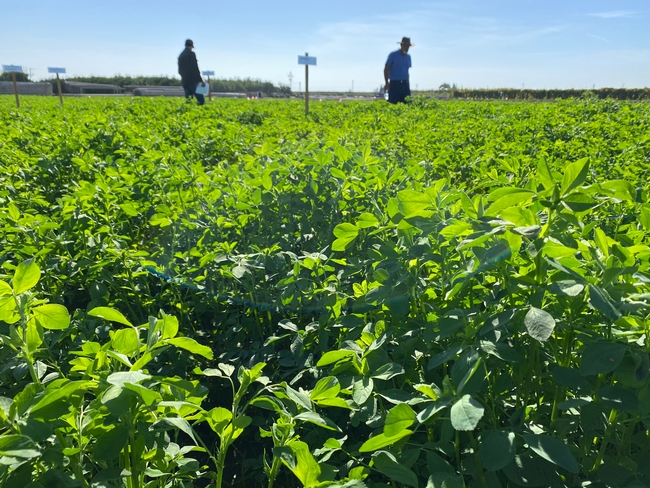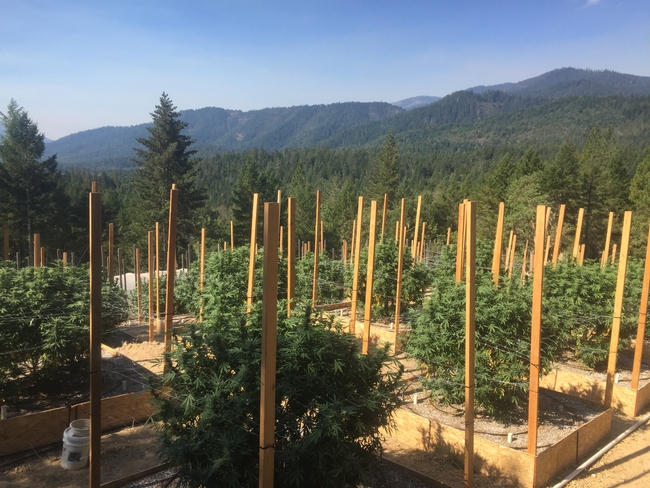
Posts Tagged: Land
$1.7M granted for climate-smart planning led by UC ANR scientists
In California, natural and working lands make up 95 million acres of the state and play a vital role in building resilience to the impacts of climate change. University of California Agriculture and Natural Resources was awarded $1.7 million for the California Next Generation and Equitable Climate Action Plan, as part of the state's Natural and Working Lands Climate Smart Strategy and California's 30x30 Initiative, an effort to conserve 30% of the state's lands and coastal waters by 2030.
Natural and working lands include both unmanaged and managed areas actively used for agriculture, forestry or production purposes.
Chandra Richards, UC Cooperative Extension agricultural land acquisitions academic coordinator for Southern California, and Cristina Murillo-Barrick, UCCE's Black, Indigenous and People of Color community development advisor for the Bay Area, are leading the California Next Generation and Equitable Climate Action Plan project.
To build capacity and technical assistance for climate-smart action planning, Richards and Murillo-Barrick will use the Climate Smart Land Management Program funding, awarded through the California Department of Conservation, to focus on two of the most pressing climate action issues: equitable land access and land management diversification.
According to the 2022 U.S. Department of Agriculture census, demographic data indicates that California agricultural land ownership and production is concentrated within an aging and mostly White demographic. However, research suggests diverse management practices promote healthy landscapes. This has been shown to benefit the environment, human health and climate resilience in multiple ways.
For this reason, this project centers on “historically underrepresented communities,” a term that includes California Native American Tribes, communities of color, landless farmers, immigrant and non-English speaking communities and other agency-designated minority groups (racial, ethnic and non-male groups, socially disadvantaged farmers and ranchers, and California designated severely disadvantaged communities).
Focusing on Southern California, UC Cooperative Extension scientists will identify barriers to land access, management and opportunities to increase land manager diversity. They also will engage historically underrepresented communities in coalition building, capacity assessment and climate action planning.
Within the last few decades, Californians have faced increased ecosystem stressors and decreasing diversity of natural systems. This pattern continues to damage already-vulnerable communities (disproportionately historically underrepresented communities), while also worsening and intensifying climate impacts, including drought, wildfire, flooding and disease. Overcoming these kinds of systemic and structural challenges will require the next generation of land managers to reflect California equitably, while preparing them to take on climate resilience. The project will determine clear solutions and plans that enable long-term, strategic land use and protection.
To do this work, UCCE is collaborating with the Community Alliance with Family Farms (CAFF), California Association of Resource Conservation Districts (CARCD) and the California Bountiful Foundation, all of whom serve as subgrantees and will deepen connections with communities.
Organizations like CARCD have long served as “boots on the ground” personnel and have close relationships with landowners and land managers. “RCDs have been hearing the land equity need for a long time and are actively collaborating with different partners to tackle this pressing issue,” said Qi Zhou, program manager of Justice, Equity, Diversity and Inclusion at CARCD and member of the Strategic Growth Council Land Equity Task Force.
“California RCDs are excited about this project because it will allow major California agriculture and conservation partners to collaboratively develop plans and implement projects centering on equity land access and land management diversification,” Zhou added.
Project lead Richards said $270,000 of the grant will be reserved for new partnerships with organizations in Southern California that have experience with, and strong ties to, historically underserved communities.
UC ANR is collaborating with the California Department of Food and Agriculture as well as California Climate and Agriculture Network (CalCAN), and World Be Well, a Southern California nonprofit.
Tawny Mata, CDFA's director of the Office of Environmental Farming and Innovation, described technical assistance providers as being grounded in their local agricultural communities and recognized their importance to partners in the success of CDFA's incentive programs.
“When we do succeed in reaching historically underserved farmers and ranchers with our grant programs, it is often with the thoughtful support and planning of a technical assistance provider,” Mata said. “I look forward to this project helping us refine our own technical assistance funding programs and bringing technical assistance providers together to network and share best practices for improving land access and promoting climate-smart agriculture.”
“The successes of this project will elevate the voices of historically underrepresented communities, strengthening efforts in these communities to support climate action,” said Richards. Additionally, the project will increase sharing of regional reports, needs assessments and community plans surrounding climate-smart management practices. Finally, it will boost technical assistance for these groups specifically.
To learn more about the Climate Smart Land Management Program and this year's awardees, visit:
Exploring the complexities of cannabis farming in rural areas
Land use change in agricultural frontiers can have far-reaching social and environmental implications, such as habitat loss, water contamination, or worker demographic shifts — particularly when it involves the rapid expansion of a new industry such as cannabis production. A recent study published in Landscape and Urban Planning offers an interdisciplinary perspective on the drivers of cannabis production in rural areas, using interviews with farmers and spatial modeling to uncover key factors.
Led by researchers from UC Berkeley's Department of Environmental Science, Policy, and Management (ESPM) and the Cannabis Research Center, the article “Where money grows on trees: a socio-ecological assessment of land use change in an agricultural frontier” provides a social-ecological systems approach for assessing drivers of cannabis production in Southern Oregon, using interviews with farmers and spatial modeling to uncover key factors.
"Unlike other crops, we have less understanding of where and how cannabis is grown, making it an important area of ongoing research," said Van Butsic, a professor of cooperative extension in ESPM and the senior author of the study.
The researchers interviewed 14 cannabis farmers to identify major themes around their relationships with land use, and used those themes to generate predictors for models of land use change. Most of the interview-derived drivers were significantly associated with cannabis distribution and development, including parcel size, human footprint, distance to the nearest cannabis farm, the density of local cannabis production, clearable land cover, farm zoning, elevation, roughness, and distance to rivers. The interview data also provided insights into the relationship of cannabis with social and environmental dynamics.
“We gained many insights from the interview data,” said lead author and ESPM postdoctoral scholar Phoebe Parker-Shames. “For example, we knew from previous research that cannabis development tends to be clustered, but we understand a little better now that this is related to the ways in which cannabis farmers rely on each other to share knowledge, labor, and navigate uncertainty during difficult policy changes.”
One of the major themes that emerged from the interview data was the environmental stewardship values of the farmers. “There is a large untapped potential for education and management outreach to target farmers who got into this industry in part because of their ability to connect with the land,” Parker-Shames said. “The farmers we spoke to had a genuine desire to learn best practices in an industry without a lot of formal standards for production. I'm grateful that they were willing to share their experiences and insights with us.”
Additional Berkeley co-authors include ESPM professor Justin Brashares and alumni Hekia Bodwitch (PhD '17 ESPM). The study's findings provide valuable insights into the drivers of cannabis production and the environmental stewardship values of cannabis farmers, which can inform environmental policy, regulation, and best practices for sustainable cannabis production.
Dogging the Dogface Butterfly
They dogged the dogface butterfly. In celebrating the California dogface butterfly, Zerene eurydice, visitors at the Bohart Museum of Entomology open house learned about the biology and history of the insect, engaged in arts and crafts, and enjoyed two specially decorated sheet...
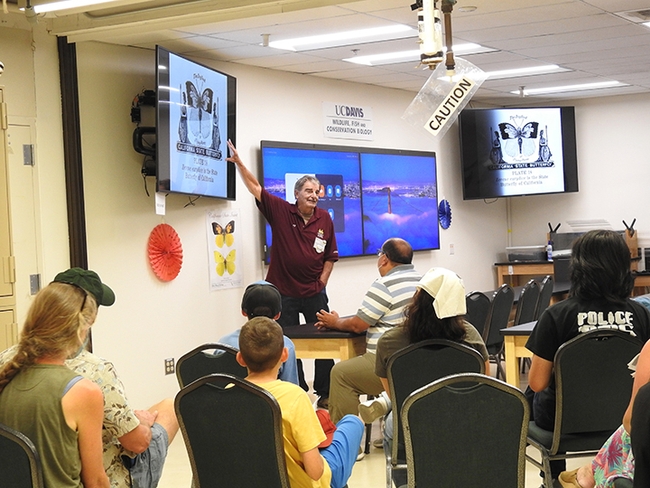
Bohart associate Greg Kareofelas talks about the history of the California dogface butterfly. (Photo by Kathy Keatley Garvey)
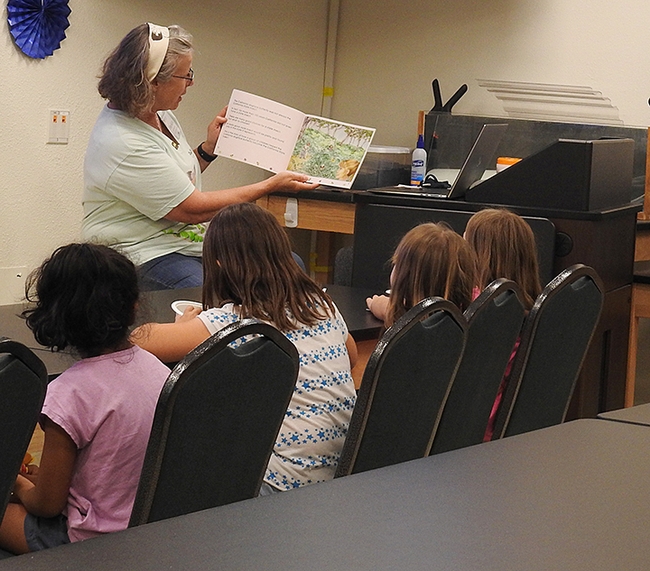
Professor Fran Keller of Folsom Lake College reads her children’s book, “The Story of the Dogface Butterfly,” available in the gift Shop. (Photo by Kathy Keatley Garvey)
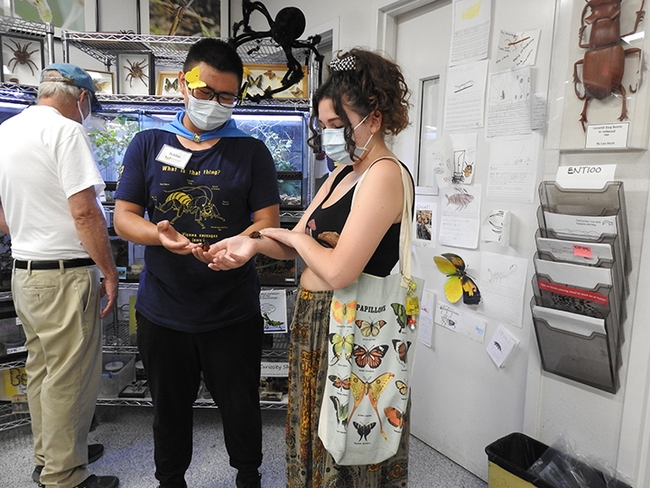
UC Davis students Kaitai Liu and Sol Wantz check out the Bohart’s live petting zoo, including Madagascar hissing cockroaches, and stick insects. Wantz is the incoming president of the UC Davis Entomology Club. (Photo by Kathy Keatley Garvey)
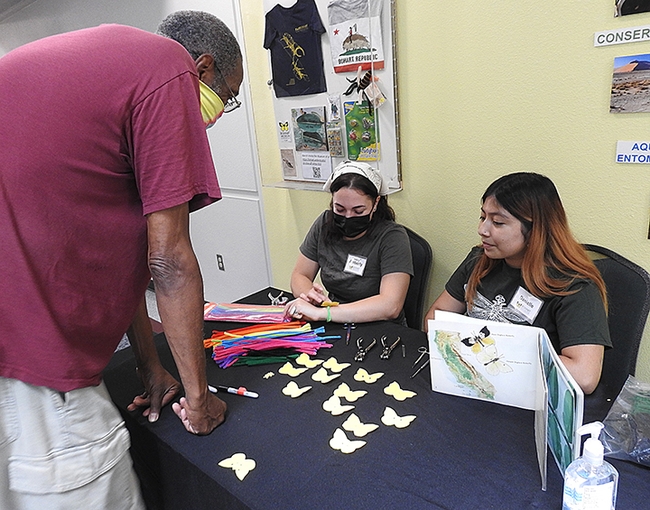
UC Davis students Danielle Sion and Amberly Hackmann staff the felt dogface butterfly table.(Photo by Kathy Keatley Garvey)
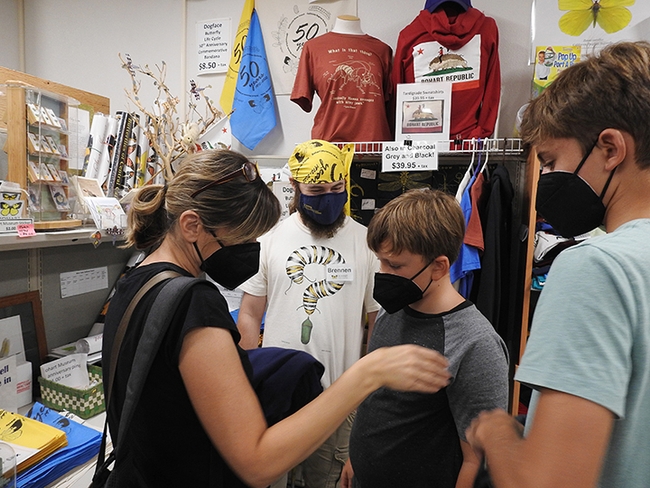
Bohart Museum lab assistant Brennen Dyer (in back, center) staffs the Bohart Museum gift shop. (Photo by Kathy Keatley Garvey)
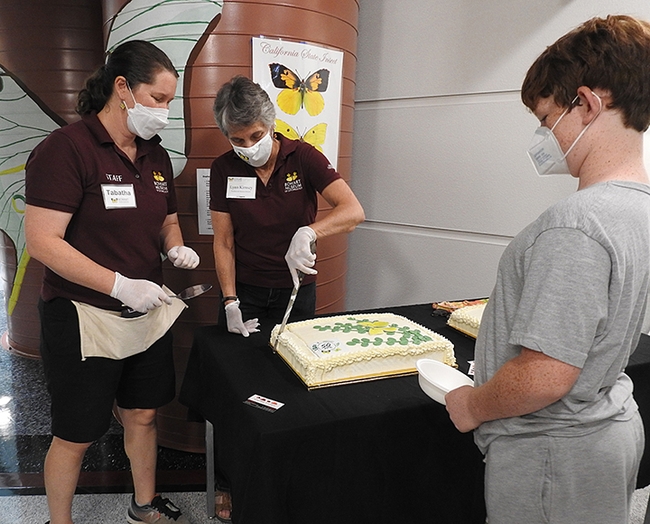
Lynn Kimsey (right) director of the Bohart Museum of Entomology and Tabatha Yang, education and outreach coordinator, cut one of the two specially made cakes. (Photo by Kathy Keatley Garvey)

Guests enjoyed the specially made cakes featuring a male dogface butterfly (shown) and a female dogface butterfly. They were the work of Tiffany Warrick of CreaTions N' EvenTs, Sacramento. (Photo by Kathy Keatley Garvey)
Bohart Open House: Celebrating the California Dogface Butterfly
What's the story behind how and why the California dogface butterfly was designated as the state insect 50 years ago? That story will be among the highlights of the Bohart Museum of Entomology open house from 1 to 4 p.m., Saturday, July 16 in Room 1124 in celebration of the 50th...
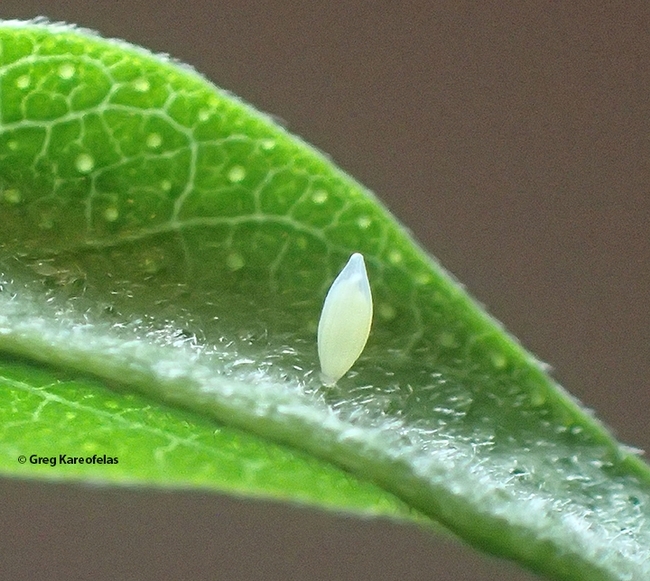
The egg of the California dogface butterfly, Zerene eurydice. (Photo by Greg Kareofelas)
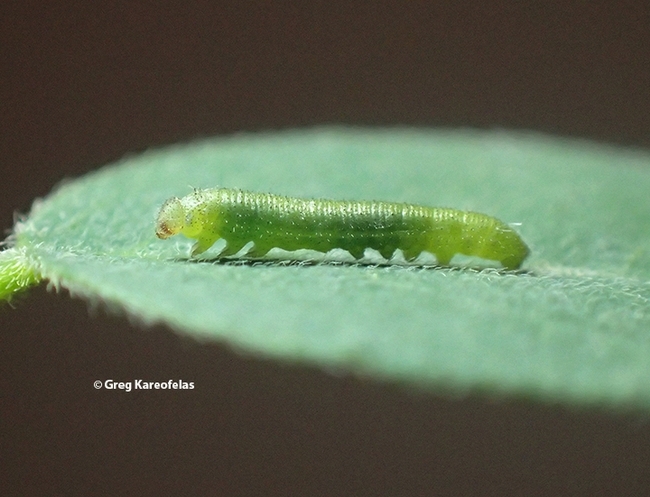
The caterpillar or larva of the California dogface butterfly, Zerene eurydice. (Photo by Greg Kareofelas)
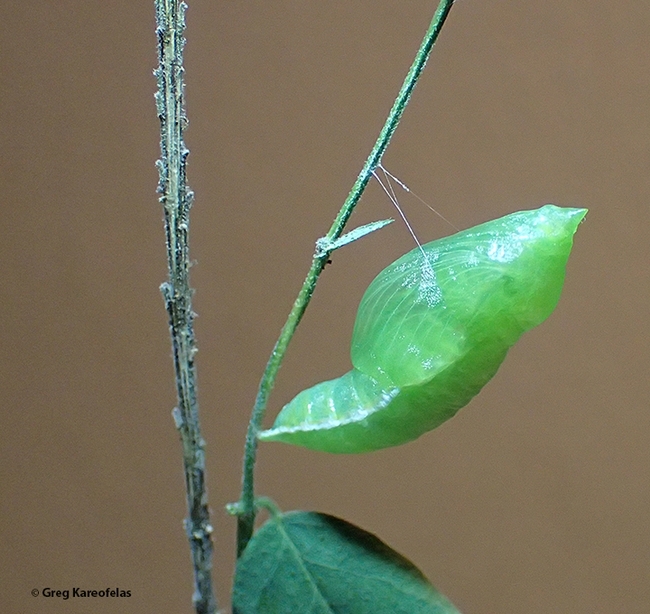
The chrysalis of the California dogface butterfly, Zerene eurydice. (Photo by Greg Kareofelas)
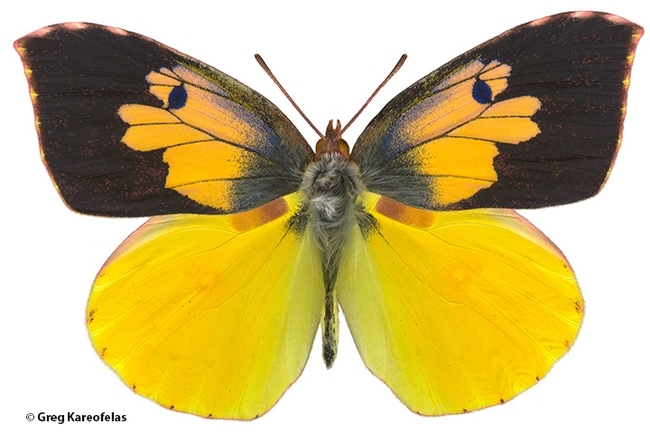
An adult male California dogface butterfly, Zerene eurydice. (Photo by Greg Kareofelas)
The Land of Z (Zerene) and The Land of B (Bohart)
Friday, June 10 proved to be a great day in "The Land of Z," and Saturday, July 16 promises to be a great day in the "Land of B." The Land of Z? It's the home or major breeding ground of Zerene eurydice, the California dogface butterfly, the state insect. Where is this major breeding ground:...
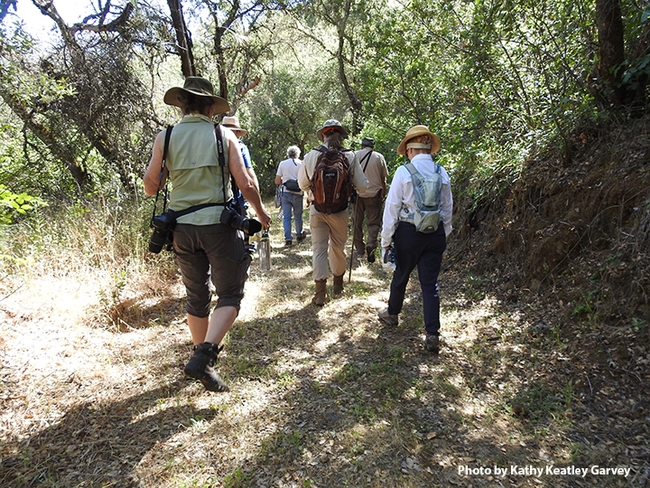
And the tour of the California dogface butterfly habitat begins. (Photo by Kathy Keatley Garvey)
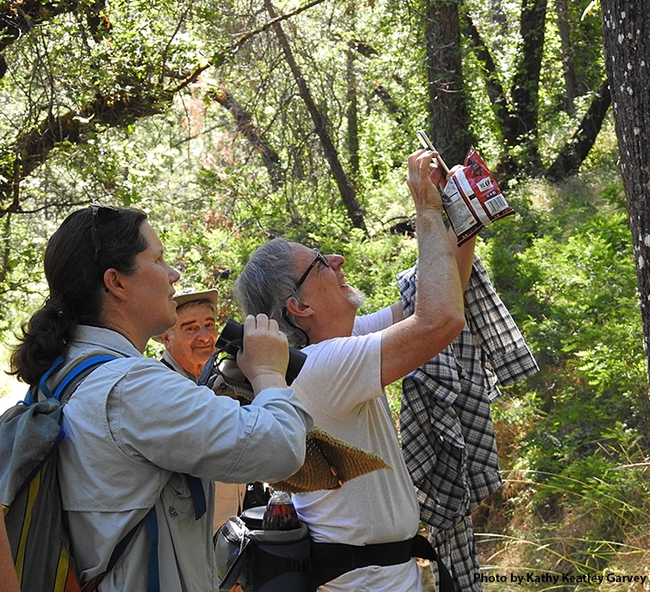
Tabatha Yang and Steve Heydon of the Bohart crew photograph California dogface butterflies. In back is Bohart associate Greg Kareofelas. "Males fly a beat, often coming down a canyon, then turning around and going back up again, and repeating," says UC Davis distinguished professor Art Shapiro. "Both sexes routinely fly 15-20 feet off the ground.(Photo by Kathy Keatley Garvey)
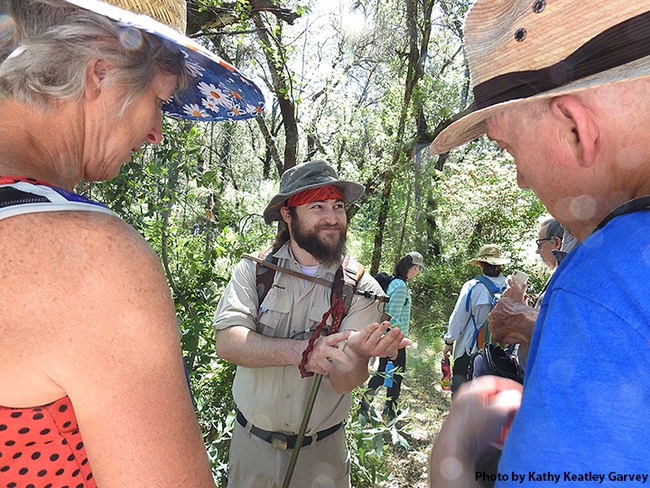
Bohart lab assistant Brennen Dyer with a California dogface butterfly. (Photo by Kathy Keatley Garvey)
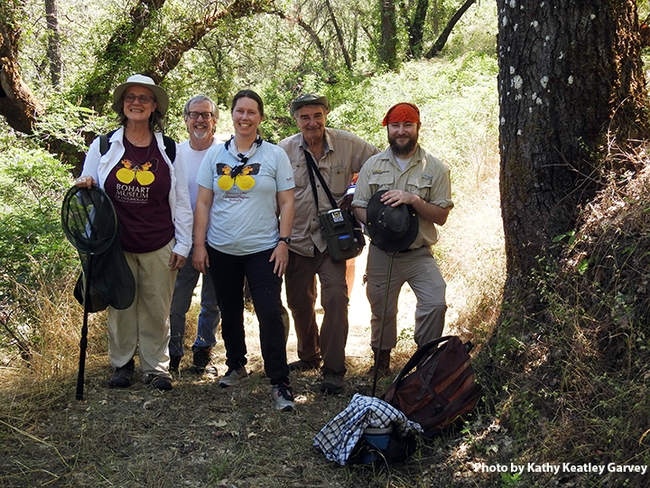
The Bohart crew on the Auburn field trip included (from left) Professor Fran Keller of Folsom Lake College, a Bohart scientist; senior museum scientist Steve Heydon; Tabatha Yang, education and outreach coordinator; Greg Kareofelas, Bohart associate and a PLT volunteer guide; and Bohart lab assistant Brennen Dyer. (Photo by Kathy Keatley Garvey)

